By Billy G. Brant
ONE OF THE most challenging aspects of dramatic presentation, whether on the stage or through the electronic media, is attaining a high level of audience involvement. Those performing in stage productions have found a partial answer in audience participation, where the audience actually takes part in the play. Those in the electronic media have a larger obstacle to overcome because they must rely upon emotional and imaginative involvement. A few television and film producers have considered a device such as Aromarama and Smell-O-Vision that would produce odors of the scenes flashed on the screen thus adding to the realism of the picture and involving the audience in that manner. Some public (non-commercial) radio stations are now returning to the dramatic art form with a series entitled "Binaural Theater" which is designed to totally involve the audience with sound.
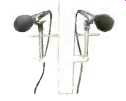
"Binaural Theater" is a series produced by the National Center of Audio Experimentation, a project of the Corp. for Public Broadcasting and the Univ. of Wisconsin, for distribution to stereo-capable public radio stations in the U.S. This series of plays combines contemporary radio drama with the newly applied technique of binaural sound. In fact, it is the use of binaural sound that separates this series from those plays produced in the early years of American broadcasting or those currently being produced in other countries.
Donald Voegeli, Technical Director of NCAE, explains, "Binaural, which means `relating to or used by both ears,' is a system of microphone placement and receiving or playing back through stereo or two-channel headphones, audio information to which your own binaural hearing can apply sense of direction, distance, movement, and other important aspects of natural human hearing. In binaural we attempt to take you to the event where the recording was made. You become a participant in the event. Your relationship to the event is much more intimate, much more real." Binaural sound engulfs the listener, stimulating him to the point of actually experiencing the situation or scene as if he were there watching it. This realism places the listener continually at the focal point of all the action, forcing him to be involved with the action. With binaural sound the listener can be in a rain storm or a riot, in the middle of an argument or directly in the path of an oncoming car. At times the sound effects in "Binaural Theater" are more impressive than the plot or the acting. However it is the acting and the production techniques associated with the acting that complete the realistic approach to drama that binaural sound provides.
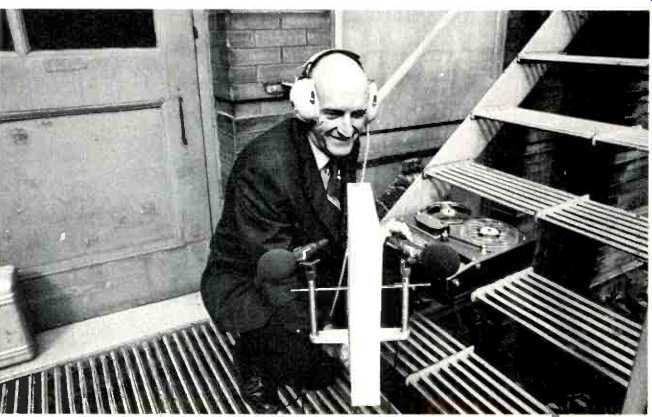
above: NCAE Director Ed Burrows demonstrates binaural recording with "Herman”.
The acting and actions performed before the microphones demand as much of a binaural director as of a stage director. Blocking must be as carefully planned as on the theatrical stage. In fact, acting in binaural sound is similar to acting on the stage. In binaural sound the listener can tell if an actor is "far left" or "down center" or "up far right." Like the stage, the actors' movements can have almost any variation. Interestingly enough, the actors must perform with even greater realism than they do on the stage because the audience does not have the advantage of a visual image to reinforce what is spoken. This is a vast change from the early radio dramas like "The Green Hornet" or "The Shadow," where the actors were required to stand in one place before a microphone and speak their lines. If they move from that spot, they would either not be heard or be heard only faintly. With binaural sound recording, the director has the opportunity to allow his actors almost unrestricted natural movement.
Most of the action of the plays in this series was recorded on location to abet the total realistic sound picture. Scenes were recorded in moving cars, in homes and on street corners. As fate would have it, some on-location recording was impossible so the director and the actors did their scenes in a studio while the appropriate sound beds (the total ambient sound of the location) were added at the proper time. The scenes were then edited and placed in order to form a smooth sounding, exciting dramatic production. Many hours of production went into the twelve plays that make up the "Binaural Theater." The result can be seen in the appreciation of this newly applied technique called binaural sound.
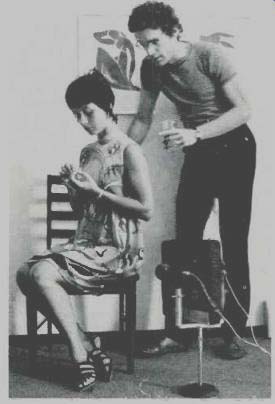
---- Mary Jane Kimbrough and Charles Kimbrough of the Milwaukee
Repertory Theater record a scene from "The Genuine Plastic Marriage" by
Julian Dickon. (Photos courtesy NCAE.)
The recording of binaural sound is accomplished with a U-shaped device affectionately dubbed "Herman" by those at NCAE. Two microphones are placed about eight inches apart with a piece of foam rubber separating them. This foam acts as a barrier to isolate the two microphones. With a little imagination, Herman would be the human head because Herman is designed to approximate the position and acoustical properties of the ears on a human head. And, this indeed is the whole idea-to record sound as the human ears would hear it.
This type of recording adds the natural realism to "Binaural Theater." To fully appreciate these effects the listener has to wear stereo-headphones. The headphones direct all of the variations of the sounds to the ears of the listener.
"Binaural Theater" is just one product of the research of the National Center for Audio Experimentation. NCAE is interested in other uses of audio besides binaural and is concerned with audio's role in other media as well as radio. Yet binaural sound experimentation at NCAE has resulted in a number of other universities, colleges and radio stations doing their own experimentation. Recently, the Univ. of South Florida began a binaural drama script competition. This is a direct outgrowth of NCAE's efforts, according to E.G. Burrows, the Director of NCAE.
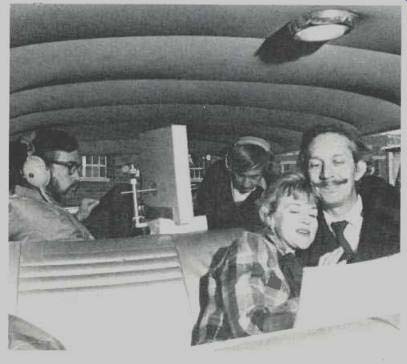
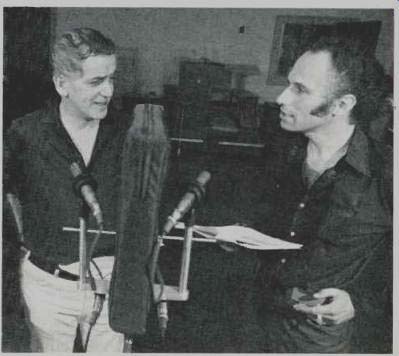
It will be interesting to see how the drama public reacts to this new and unique presentation of contemporary drama. Many who have heard these plays say that they are very good. Don Voegeli goes one better. "If radio's most glorious attributes are the stimulation of the imagination and the personal sound in the ear, here is radio at its best!"
The "Binaural Theater" is currently being aired by approximately 77 public radio stations around the country. The following are plays in the "Binaural Theater" series. The public is advised to check with their local public radio station to see if that station is carrying "Binaural Theater."
Before Tomorrow, by Colin Finbow. A romantic comedy in which a young, newly engaged couple discover they really have little in common.
Nathan and Tabileth, by Barry Bermange. A warm and sympathetic portrait of two old people whose dialogue is echoed by internal monologue. A visitor, possibly their nephew, disrupts the routine of their day.
Life by Misadventure, by Julian Dickon. A dying man in his hospital bed relives the traumatic episodes of his life involving wife, daughter, son, and mistress.
Enchanted Night, by Slawimor Mrozek. Two "commercial travelers" share a seedy hotel room and find themselves competing for the affections of a lady who is the creation of their mutual fantasies.
Guardian Angel, by Vaclov Havel. In this black comedy of contemporary life, a successful playwright is given unwelcome help from a mysterious stranger claiming to be his "guardian angel." Echoes, by Rhys Adrian. Through a series of "echoes" like snapshots in an album, an elderly couple review the trivia of their past and present lives.
The Genuine Plastic Marriage, by Julian Dickon. In this "normal" marriage characterized by boredom and disillusion, self-revelation leads only to a widening of the gap between husband and wife.
Timepiece, by Stanley Eveling. A clock plays a key role in a man's gradual but not entirely unpleasant descent into madness.
All Night Store, by E.G. Burrows. One woman's nightmare walk down a lonely road at night. This play was written especially for binaural presentation.
The Yellow Room, by Donald Hall. The author reads this collage of love poems taken from his book, The Yellow Room.
The Mortification, by Barry Bermange. A corporation employee finds himself a victim of the system as he is mysteriously transferred to subterranean offices.
"Binaural Theater" is new and exciting. This series might begin a Renaissance of radio drama in the United States.
(Audio magazine, Nov. 1972)
Also see:
A History of Binaural Sound (Mar. 1986)
Binaural Overview: Ears Where the Mikes Are--part 1 (Nov. 1989)
Illusions for Stereo Headphones (Mar. 1987)
Headphones around the house (May 1974)
Headphones: History and Measurement (May 1978)
The Filter in out Ears (Sept. 1986)
Confessions of a Loudspeaker Salesman (Mar. 1986)
= = = =